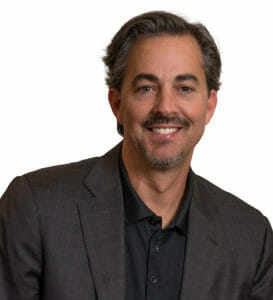
After two years of operating during a public health emergency, skilled nursing leaders are looking to reinvigorate their workforces, facilities and the industry. McKnight’s Long-Term Care News asks: What will it take to advance “Onward and Upward?”
Even some of the most progressive long-term care executives have had to put deep, strategic initiatives aside while coping with historically challenging pandemic conditions.
But there will soon be a time — maybe even this month — when attention and resources start to shift toward strategies that have been paused. That is the view of optimistic industry veteran Steve Fogg, CFO for Marquis Companies and Consonus Healthcare, and a fourth-generation long-term care executive.
Included in his vision for the industry’s future are “creative reimbursement funding” vehicles, such as institutional special needs plans and accountable care organizations; training more nurses and other clinical professionals to restock a ravaged workforce; and pursuing construction and ramping up services to meet a tidal wave of baby boomers.
“I believe we’re getting closer to where we can move out of this pandemic and call it an endemic or whatever else you want to call it. It’s probably not ever going to go all the way away,” Fogg told McKnight’s Long-Term Care News. “Omicron is dropping so fast. I think that in the next two to three weeks, you could potentially see some of these discussions [about progress] starting.

“Recovery is going to be slow,” he added in comments Thursday. “It’s going to take time for seniors and families to make the decisions that, yes, I want to come back to a skilled nursing facility, but eventually they will do that. And we’ll be ready for it.”
Fogg said one of the big post-pandemic challenges will be overcoming hospitals’ shift toward sending more seniors directly home after surgery, often because of perceived nursing home risks exposed during the pandemic.
“I’m a big believer in what it is we do, and when the pandemic is over, we will be able to get back to [the referral patterns] where we were,” he said.
Milwaukie, OR-based Marquis operates 28 skilled nursing, assisted living and memory care facilities. Its sister company Consonus Healthcare provides rehab, pharmacy, and post-acute care consulting in more than 370 facilities nationwide.
Growth in therapy and pharmacy services is expected to outpace the companies’ plans for controlled building expansion.
‘Creative’ fan
To say Fogg is a proponent of providers etching their own roadmaps via alternative funding means such as Institutional Special Needs Plan (I-SNP) or other risk-bearing efforts would be putting it mildly.
“I would probably grow that a bit bigger than that to say any type of creative reimbursement funding, whether in the form of a value-based payment arrangement, ACO or providers entering into the insurance space to be able to manage the healthcare dollar of their residents,” he explained. “Anything creative like that, I’m definitely bullish on. Providers who make the decision not to participate in those, I believe they’re going to find it’s challenging to continue to be viable.”
Once we get through this, I would expect to see the number of providers on special needs plans continue to grow at a pretty heavy rate.
Steve Fogg
Marquis was one of the first providers in the country to establish its own I-SNP. The self-insurance plan covers all the benefits of Medicare parts A, B and D for plan members. Its AgeRight clinical services entity provides physician and nurse practitioner services in each of its buildings every day.
“The AgeRight division has the potential of having exponential growth as we work with other providers in our space and either align with them or move those products into their buildings,” Fogg said.
“It’s probably the thing that excites us the most. It has the potential of providing some of the best benefits to residents in our industry. Once we get through this (pandemic), I would expect to see the number of providers on special needs plans continue to grow at a pretty heavy rate.”
Nationwide movement
The leader of a special American Health Care Association council promoting I-SNPs, Fogg estimates the number of provider-run I-SNPs is in the low 50s. Without the pandemic, he estimates it would be in the 70s or 80s. It was just 22 in 2019.
Marquis’ I-SNP membership grew about 40% in the two years leading up to the pandemic, to nearly 700 patients. Marquis partnered with fellow Northwest provider Avamere in a special self-insurance effort before COVID-19 but that effort has been “pretty flat” due to occupancy deterioration
The plan, however, has remained economically viable during the pandemic and covered COVID patients well. Others around the country may have been challenged covering certain related hospital visits, Fogg acknowledged.
“It’s probably been the best thing for our residents in the SNFs during this time, and for the families of residents, knowing that there were physicians and nurse practitioners in our buildings every day to help monitor changes in condition, or if they tested positive,” he explained. “They had that resource. I think families felt secure, knowing that that level of professional was in the building, along with the typical nurses who are always there as well.”
Fighting ‘crazy town’
While solutions won’t be simple to execute, the needs are clear, Fogg feels.
Workforce development, of course, is the elephant in the room. While Marquis leaders believe the non-professional workforce will return to strength when pandemic conditions subside, there is uneasiness about skilled clinicians.
“What really scares us and concerns us is the professional workforce, whether nurses or therapists,” Fogg said. “Having enough people to care for the residents is a very frightening and scary thing. Hopefully as an industry, all of us can come up with strategies and new approaches to attract that new workforce in.”
The desire is that nursing school registrations will rise — with a greater willingness of schools to broaden their recruiting and capacity, Fogg said.
“It appears as if nursing schools want to maintain their accreditations or ratings by limiting the number of students they have, which allows them to be more selective about who they bring in and drive better results,” Fogg said. “To me, that’s just crazy town, but it seems that happens.”
He hopes the industry can exert pressure to change regulations and policies that don’t promote nursing school growth.
“Certainly, the tangible inflation in wages that are being paid in our industry through the pandemic — I hope that is another way we’re going to attract more people, just because of what wage rates are, versus what they used to be,” he added.
The smarter way
He feels his companies’ growing use of data analytics has been a differentiator, particularly with workforce matters.
“We’ve got a set of metrics on workforce supply even before people come to work for us. We learn how we’re doing with inquiries, what’s giving us the best return in terms of spending money to bring workforce in, why people are leaving us.”
He said one of the most interesting technological advances has been gaining the ability to understand which external sources are attracting the most and best work candidates.
“It allows us to position our dollars that we have budgeted for that (recruitment) in the right spot to give us the best return,” he said. “I’ve enjoyed being able to see where we get the most new hires.”
Embracing age discrimination
Marquis will build new facilities or acquire only very new ones to address what it considers the industry’s second-biggest concern: the aging of physical plants.
“It’s going to be a building that is fairly new or in pretty good shape as a plant. As an organization, we made that decision. I wouldn’t say that’s an industry wide position,” explained Fogg, who has closed more than $250 million in transactions. “It mitigates our risk that we end up with buildings that are no longer usable or obsolete. I think you’ll see more providers embracing that philosophy.”
Marquis will build SNFs that are smaller and focused only on “anything and everything around catering to the short-stay resident.”
There could be a doubling of the number of the facilities, or even greater than that, of what we have today because of the needs of that group.
Steve Fogg
The goal is “having adequate space for therapy services and other services done with the short-stay population, versus an old, small short-stay facility that was built where there wasn’t much in the way for short-stays.”
“Location in the market is another big driver,” he added. “Proximity to the hospital is a huge driver for us.”
Managing crowds
The pandemic’s overall slowdown could cause problems as the baby boomers start to jam the pipeline and building projects amble through production, he believes.
“There’s not a lot of thinking about new construction or new development. So the longer it takes to get out of this and have the industry recover, it could lead to delays in new development that are absolutely necessary for the boomers.
“There could be a doubling of the number of the facilities, or even greater than that, of what we have today because of the needs of that group,” he observed. “That can’t happen overnight.”
Expect success, achieve success
Fogg believes in the approach “attitude determines altitude.”
“While it’s been the most challenging times of our career, we’re eternally optimistic, so we always look at the bright side,” he said of him and his brother, company President and CEO Phil Fogg Jr.
“It certainly helps to bring that type of feeling into your culture,” he added. “If you’re in an environment where it’s not like that, you’re going to have a harder challenge.”



